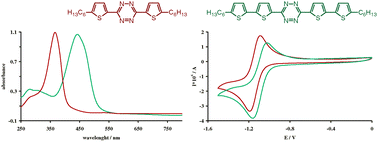Effect of substituents on redox, spectroscopic and structural properties of conjugated diaryltetrazines—a combined experimental and theoretical study†
Abstract
Two series of new soluble conjugated compounds containing

* Corresponding authors
a
Faculty of Chemistry, Warsaw University of Technology, Noakowskiego 3, 00 664 Warszawa, Poland
E-mail:
zagorska@ch.pw.edu.pl
b
INAC/SPrAM (UMR 5819 CEA-CNRS-Univ. J. Fourier-Grenoble 1), Laboratoire d’Electronique Moléculaire Organique et Hybride, 17 Rue des Martyrs, 38054 Grenoble Cedex 9, France
E-mail:
adam.pron@cea.fr
c Institute of Physical Chemistry and Chemical Physics, Slovak University of Technology in Bratislava, SK-81 237 Bratislava, Slovakia
d INAC/SCIB CEA Grenoble, 17 Rue des Martyrs, 38054 Grenoble Cedex 9, France
Two series of new soluble conjugated compounds containing

 Please wait while we load your content...
Something went wrong. Try again?
Please wait while we load your content...
Something went wrong. Try again?
E. Kurach, D. Djurado, J. Rimarčik, A. Kornet, M. Wlostowski, V. Lukeš, J. Pécaut, M. Zagorska and A. Pron, Phys. Chem. Chem. Phys., 2011, 13, 2690 DOI: 10.1039/C0CP01553A
To request permission to reproduce material from this article, please go to the Copyright Clearance Center request page.
If you are an author contributing to an RSC publication, you do not need to request permission provided correct acknowledgement is given.
If you are the author of this article, you do not need to request permission to reproduce figures and diagrams provided correct acknowledgement is given. If you want to reproduce the whole article in a third-party publication (excluding your thesis/dissertation for which permission is not required) please go to the Copyright Clearance Center request page.
Read more about how to correctly acknowledge RSC content.
 Fetching data from CrossRef.
Fetching data from CrossRef.
This may take some time to load.
Loading related content
